KK Women’s and Children’s Hospital (KKH) Paediatric Neurology and Physiotherapy departments techniques and positions to help a child with breathing difficulties breathe easier and better.
Chest Physiotherapy (CPT) is a series of manual techniques and positions that helps the child to breathe better. It is especially useful when there is either an overproduction of mucus, or when the mucus is too thick. CPT assists with loosening and moving mucus out of the lungs and to improve air entry within.
Safety precautions when exercising
Ensure that you had been taught the recommended exercises by a physiotherapist before carrying them out.
Position the child comfortably with the use of towels or pillows.
Observe for signs of pain or discomfort – if pain occurs, stop and check in with your physiotherapist before continuing further.
Do not do exercises immediately after feeding due to risk of regurgitation. Ensure that the child was fed at least one to two hours prior to commencement of chest physiotherapy.
Your exercise regime
 Repeat exercises every day or as instructed by your physiotherapist. CPT works best in the morning by removing mucus that has built up during the night.
Repeat exercises every day or as instructed by your physiotherapist. CPT works best in the morning by removing mucus that has built up during the night.
 Increase frequency of CPT when there is higher production of mucus or increasing suctioning requirements.
Increase frequency of CPT when there is higher production of mucus or increasing suctioning requirements.
 Employ the use of CPT prior to suctioning if the child presents with chesty cough that does not clear with suctioning alone.
Employ the use of CPT prior to suctioning if the child presents with chesty cough that does not clear with suctioning alone.
 One session of CPT will usually take 20 to 40 minutes including suctioning manoeuvres.
One session of CPT will usually take 20 to 40 minutes including suctioning manoeuvres.
 If a nebuliser of metered dose inhaler is prescribed, the Inhaled medication should be taken before CPT. The medicine, positioning, and percussion all work together to clear the mucus from the lungs.
If a nebuliser of metered dose inhaler is prescribed, the Inhaled medication should be taken before CPT. The medicine, positioning, and percussion all work together to clear the mucus from the lungs.
Chest Percussion
Percussion is when you clap your child’s chest to help move and loosen secretions from inside the lungs. It involves rhythmical clapping using a hand on the child’s chest wall.
Percussion
Aim: To loosen mucus within the lungs by clapping against the ribs rhythmically and facilitate it to move into larger airways of the lungs.
Instruction: Cup your hands and create a pocket of air between your hand and the child’s chest. Try to keep your arms relaxed and do the movements with your wrists. Always ensure you percuss over ribs and never below the ribs or on the stomach as the lungs are within the chest cavity and protected by ribs. You should do percussions in each region of the lung for 3 to 5 minutes before moving to another region of the lung.
Precaution: Although chest percussions may sound loud,
it should never be painful. Never percuss over bare skin. Make sure the child is wearing a thin layer of clothes. If the child is wearing clothing with thick seams, or has buttons that will interfere with percussion, remove it and drape a soft towel over the spot that will be percussed. Never percuss over the spine, sternum, or on any intravenous tube, port-a-cath, or feeding tube. | 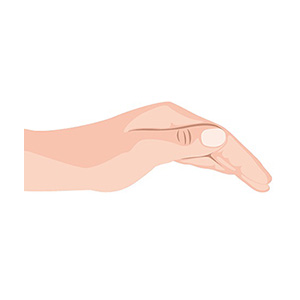 |
Postural Drainage
Postural drainage removes mucus from certain portions of the lungs with the use of gravity. By placing the child in different positions, mucus drains to the central airways where it can be easily coughed out.
Side lying
Aim: To drain mucus from smaller airways of either side of the lung into central airways
Instruction: Position the child in side lying on either your lap or a pillow for 15 to 30 minutes as tolerated. You can either do percussion in this position or instil prescribed inhaled medications to target affected lung lobes more effectively. You can position the child to alternate side lie or lie on one side more than the other as advised by the physiotherapist. |
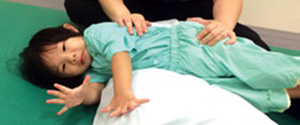
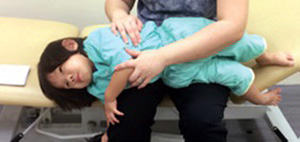 |
Prone
Aim: To mobilise mucus from the posterior lung fields, to allow upper airway mucus to drain with the assistance of gravity, and to improve ventilation-perfusion matching with the lung fields.
Instruction: Position the child lying on their tummy either on your lap or on a pillow. Hold the child comfortably for 15 to 30 minutes. You can do percussions over their ribs in this position.
Precaution: Only attempt this position at least one to two hours after feeding. If the child has a PEG, ensure the abdominal area is not rubbing against supporting surfaces by inserting a towel roll under the chest and the hips. Always intermittently check on the PEG site. | 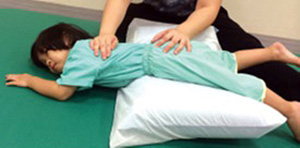
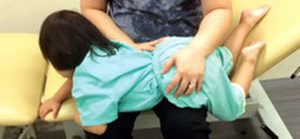 |
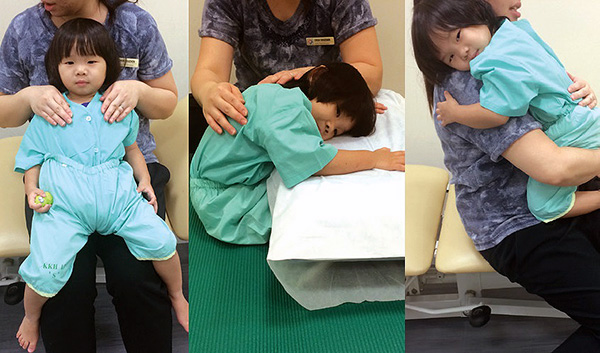 |
Upright positioning (above) Aim: To improve lung expansion as gravity pulls the diaphragm downwards, allowing improved expansion and ventilation. Instruction: You can either sit the child on your knee, supporting their head under their chin, or allow the child to rest their head on a pillow or on you while in upright. Percussions can also be done comfortably in this position. |
After chest physiotherapy (CPT)
The child may cough more during or 1 to 2 hours after CPT. Coughing assists in get rid of loosened mucus
After swallowing a large amount of mucus, the child may feel sick to the stomach and throw up. As soon as the child is old enough to learn to spit, teach the child how to spit the mucus out onto a tissue paper instead of swallowing it
Breathing activities (for children aged 2 and above)
Breathing exercises can improve diaphragmatic excursion to improve breathing and coughing effort
Singing songs using high and low pitches with holds
Drinking from a long straw
Pretending to blow out candles
Blowing bubbles or cotton balls across a table
Making animal sounds
Ref: K21
